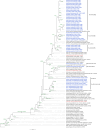Genetic diversity of A(H5N1) avian influenza viruses isolated from birds and seals in Russia in 2023
- PMID: 40369040
- PMCID: PMC12078558
- DOI: 10.1038/s41598-025-00417-4
Genetic diversity of A(H5N1) avian influenza viruses isolated from birds and seals in Russia in 2023
Abstract
Thousands of outbreaks of the highly pathogenic avian influenza A(H5N1) virus in birds and an increasing number of mammal infections are registered annually. In 2023, multiple avian influenza outbreaks were registered among wild birds, poultry and seals in Russia. The genetic characterization of seventy-seven avian viruses and three viruses from seals showed that they belonged to the 2.3.4.4b clade and represented four distinct reassortant genotypes. The majority of viruses represented genotype BB, which was widespread in Europe in 2023. Viruses from seals and four viruses from birds, isolated from outbreaks in the Far East region, belonged to the G1 (A3) genotype and had the amino acid substitution N319K in the NP protein, previously associated with an increased virulence for mammals. In addition, one virus of the G10 genotype and two viruses, representing a previously undescribed genotype (designated as Ru-23-G4) were identified. The viruses analyzed showed normal inhibition by neuraminidase inhibitors. Seven viruses had genetic markers of amantadine resistance. All the influenza A(H5N1) viruses studied showed a binding preference for α2-3-linked sialic acids, suggesting a low risk of transmission among humans. Nevertheless, monitoring of reassortment and mammalian adaptation mutations is essential for the timely identification of viruses with increased pandemic potential.
© 2025. The Author(s).
Conflict of interest statement
Declarations. Competing interests: The authors declare no competing interests.
Figures
References
-
- Youk, S. et al. H5N1 highly pathogenic avian influenza clade 2.3.4.4b in wild and domestic birds: Introductions into the United States and reassortments, December 2021–April 2022. Virology587, 109860. 10.1016/j.virol.2023.109860 (2023). - PubMed
-
- CDC. Highlights in the History of Avian Influenza (Bird Flu) Timeline—2020–2024. https://www.cdc.gov/flu/avianflu/timeline/avian-timeline-2020s.htm. Accessed August 2024.
MeSH terms
LinkOut - more resources
Full Text Sources
Medical
Miscellaneous



